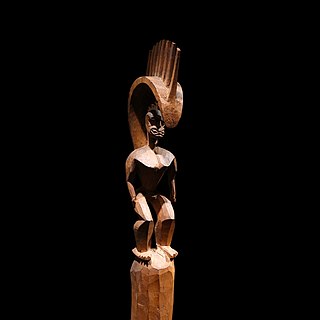In Hawaiian mythology, Kāne is considered the highest of the three major Hawaiian deities, along with Kū and Lono. He represented the god of procreation and was worshipped as ancestor of chiefs and commoners. Kāne is the creator and gives life associated with dawn, sun and sky. No human sacrifice or laborious ritual was needed in the worship of Kāne. In the Kumuhonua legend, he created Earth, bestowed upon it sea creatures, animals, plants, as well as created man and woman.
In Hawaiian mythology, an ʻaumakua is a personal or family god that originated as a deified ancestor, and which takes on physical forms such as spirit vehicles. An 'aumakua may manifest as a shark, owl, bird, octopus, or inanimate objects such as plants or rocks. The word ʻaumakua means ancestor gods and is derived from the Hawaiian words au which means period of time or era, and makua meaning parent, parent generation, or ancestor. Hawaiians believed that deceased family members would transform into ʻaumakua and watch over their descendants with a loving concern for them while also being the judge and jury of their actions.

In Hawaiian religion, the god Lono is associated with fertility, agriculture, rainfall, music and peace. In one of the many Hawaiian stories of Lono, he is a fertility and music god who descended to Earth on a rainbow to marry Laka. In agricultural and planting traditions, Lono was identified with rain and food plants. He was one of the four gods who existed before the world was created. Lono was also the god of peace. In his honor, the great annual festival of the Makahiki was held. During this period, war and unnecessary work was kapu (forbidden).
Paʻao is a figure from Hawaii. He is most likely a Hawaiian historical character retold through Hawaiian legend. According to Hawaiian tradition and folklore, he is said to have been a high priest from Kahiki, specifically "Wewaʻu" and "ʻUpolu." In Hawaiian prose and chant, the term "Kahiki" is applied in reference to any land outside of Hawaii: the linguistic root is conclusively derived from Tahiti. "Upolu" point to actual places in Samoa; and, Hawaiian scholars and royal commentators consistently claim Paʻao came from Samoa.

Rubus hawaiensis, also called the ʻĀkala, is one of two species commonly known as Hawaiian raspberry, endemic to Hawaii. It is found on the islands of Kauaʻi, Molokaʻi, Maui, O'ahu, and Hawaiʻi in mesic to wet forest at elevations of 600–3,070 m (1,970–10,070 ft). In most areas it is not common, but in some places it can be a dominant member of the understory vegetation. Although superficially similar to the other Hawaiian species, Rubus macraei, the two are believed to be derived from separate dispersals to Hawaii.

In Hawaiian religion, Māui is a culture hero and ancient chief who appears in several different genealogies. In the Kumulipo, he is the son of ʻAkalana and his wife Hina-a-ke-ahi (Hina). This couple has four sons, Māui-mua, Māui-waena, Māui-kiʻikiʻi, and Māui-a-kalana. Māui-a-kalana's wife is named Hinakealohaila, and his son is named Nanamaoa. Māui is one of the Kupua. His name is the same as that of the Hawaiian island Maui, although native tradition holds that it is not named for him directly, but instead named after the son of Hawaii's discoverer.

Martha Warren Beckwith was an American folklorist and ethnographer who was the first chair in folklore at any university or college in the U.S.

Hawaiian religion refers to the indigenous religious beliefs and practices of native Hawaiians, also known as the kapu system. Hawaiian religion is based largely on the tapu religion common in Polynesia and likely originated among the Tahitians and other Pacific islanders who landed in Hawaiʻi between 500 and 1300 AD. It is polytheistic and animistic, with a belief in many deities and spirits, including the belief that spirits are found in non-human beings and objects such as other animals, the waves, and the sky. It was only during the reign of Kamehameha I that a ruler from Hawaii island attempted to impose a singular "Hawaiian" religion on all the Hawaiian islands that was not Christianity.
Kahokuohua was a High Chief of the Hawaiian island of Molokai in the 15th century, and he is mentioned in old chants. His title was Aliʻi Nui.
Mauiloa was a High Chief (Aliʻi) of Maui. He is mentioned in legends and old chants and was likely a semi-historical person or character from myths.
Haho was an ancient Hawaiian High Chief (Aliʻi), who was a ruler of Maui. He is mentioned in legends and old chants and is also called Hoaho.
Paumakua is a name of one ancient chief who lived in ancient Hawaii and was Alii nui of Maui. He is described in legends as a ruler of the island of Maui. His genealogy is given in ancient chant Kumulipo.

The Hawaiian hawk or ʻio is a raptor in the genus Buteo endemic to Hawaiʻi, currently restricted to the Big Island. The ʻio is one of two extant birds of prey that are native to Hawaiʻi, the other being the pueo and fossil evidence indicates that it inhabited the island of Hawaiʻi, Molokaʻi, Oʻahu, Maui and Kauaʻi at one time. Today, it is known to breed only on the Big Island, in stands of native ʻōhiʻa lehua trees. The species was protected as an endangered species in the United States, but was delisted in 2020. However, the IUCN classifies the species as Near Threatened.NatureServe considers the species Vulnerable.
Larry Lindsey Kimura was born in Waimea, Hawaii County, Hawaii, U.S.A., between his Nisei father Hisao Kimura, who had immigrated from Hiroshima, Japan, and his Hawaiian mother, Elizabeth Lindsey, who had been brought up in a predominantly Hawaiian-speaking family.
Haloa is a Hawaiian mythological figure who was born of Hawaiian gods, and is the ancestor of the Hawaiian people. The title of a well-known chant about him and the creation of the Hawaiian Islands is also "Haloa".
Keawepoepoe was the son and keiki aliʻi of aliʻi nui Lonoikahaupu and aliʻi nui wahine Kalanikauleleiaiwi who became father of the royal twins, Kamanawa and Kameʻeiamoku. He was born sometime in the 1700s and was the youngest child of his mother, who was also the wife and half sister of Keaweʻīkekahialiʻiokamoku. His name means; "round Keawe". Due to his high rank from both parents as well as his father's status as a Kauaian Lono priest, Keawepoepoe was given the kapu o pahenakalani. His lineage through his mother makes him a descendant of Haloa through Keakealanikane.
The Hale Nauā was a secret society that had existed among Hawaii's ruling class before the 1778 arrival of Captain James Cook. Believed to have originally been an organization to unite the Hawaiian aristocracy, it gradually disappeared as the influx of outside cultures changed the dynamics of the island kingdom. Kalākaua revived the Hale Nauā, purposed with educating and developing knowledge of modern sciences, art, and literature among native Hawaiians. His incarnation of the society ended with his 1891 death. In the 1970s, Rocky Jensen and other artists formed Hale Nauā III to promote Hawaii's culture through the creative arts.
Formerly known as Sargassum echinocarpum, Sargassum aquifolium is an abundant brown algae of the order Fucales, class Phaeophyceae, genus Sargassum. In Hawaii, it is commonly known as limu kala. This alga is endemic to Hawaiʻi, one out of the four endemic species of Sargassum.





